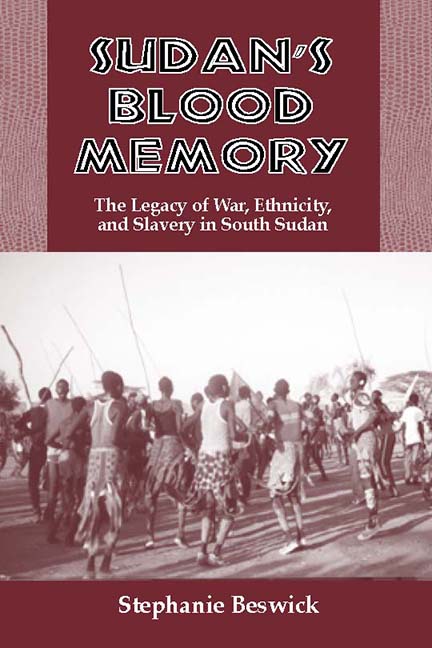Book contents
- Frontmatter
- Dedication
- Contents
- Maps
- Preface
- Acknowledgments
- A Note on Orthography and Languages
- A Note on Sources
- Map
- 1 Introduction
- 2 Geography and Brief History of Sudan
- 3 The Changing Nilotic Frontier
- The Ethno-Historical Formation of Southern Sudan
- The Ascendancy of the Dinka in Southern Sudan
- Foreign Intrusion and Its Consequences
- 15 Eighteenth-Century Slavers and Traders
- 16 Nilotic Chaos: Dinka, Nuer, Atwot, and Anyuak
- 17 Politics and Stratification among Stateless Peoples
- 18 Summary and History
- 19 Legacy of the Precolonial Era
- Notes
- Glossary
- Bibliography
- Index
18 - Summary and History
from Foreign Intrusion and Its Consequences
Published online by Cambridge University Press: 23 July 2019
- Frontmatter
- Dedication
- Contents
- Maps
- Preface
- Acknowledgments
- A Note on Orthography and Languages
- A Note on Sources
- Map
- 1 Introduction
- 2 Geography and Brief History of Sudan
- 3 The Changing Nilotic Frontier
- The Ethno-Historical Formation of Southern Sudan
- The Ascendancy of the Dinka in Southern Sudan
- Foreign Intrusion and Its Consequences
- 15 Eighteenth-Century Slavers and Traders
- 16 Nilotic Chaos: Dinka, Nuer, Atwot, and Anyuak
- 17 Politics and Stratification among Stateless Peoples
- 18 Summary and History
- 19 Legacy of the Precolonial Era
- Notes
- Glossary
- Bibliography
- Index
Summary
This chapter contains three parts: 1) a summary of the book's themes thus far, 2) a brief comparison of the various Western Nilotes of South Sudan, and 3) a brief history of precolonial Southern Sudan. In chapter 19 I examine the legacy of that history.
Thematic Summary
As I have shown, numerous themes have driven precolonial Southern Sudanese history from the fourteenth century onwards. These have included northern predation, the changing Nilotic frontier, migrations and expansion, ethnic conflict, the pastoral economy and raiding, a strong reliance on the communal religions of nature and power of the ancestors, slave raids, societal stratification and its concurrent tension, fission politics, and older forms of male dominance over females.
Northern Predation
The theme of northern predation is an historically long one in both oral histories and myths of Southern Sudan. The northernmost Western Nilotes, the Dinka, were under pressure from the Nubian Christian kingdom of Alwa in the thirteenth and fourteenth centuries. With the rise of the Islamic Sultanate of Sinnar after 1501 the Dinka, Shilluk, and numerous others faced predatory slave raids. 1 In the late eighteenth century, Islamic pastoral West African slave raiders, known as the Baggara, relocated east into the territory north of the Dinka and began to raid the Nuba Mountains. Soon thereafter, because of the attractiveness of Dinka and Nuer cattle (the cattle of the Nuba were miniature) as well as the need to raid for slaves, the northwest Dinka frontier came under severe pressure from this time onwards.
Migrations and the Changing Nilotic Frontier
The Nilotic frontier has been changing for centuries, moving in a southerly direction. The historical traditions of Nilotic migrations form an important aspect of East African history. Indeed, these migrations have concerned peoples (today broken linguistically into Western, Eastern, and Southern) who originated in central Sudan and, over a period of centuries, forged south into modern-day South Sudan, Ethiopia, Uganda, Kenya, and Tanzania. Those of South Sudan today fall into two groups: the Western and Eastern Nilotes. By far the most numerically powerful are the Western Nilotes, whose linguistic category includes the Dinka, Shilluk, Anyuak, Nuer, Luo, and Atwot.
- Type
- Chapter
- Information
- Sudan's Blood Memory , pp. 185 - 197Publisher: Boydell & BrewerPrint publication year: 2004

